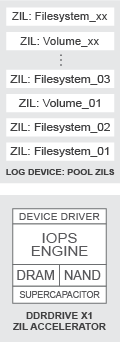LATENCY DICTATES THE DESKTOP. ™
Introduction
XNAS Storage Server
DDRdrive X1:
Solid-State
Storage System
Solid-State
Storage System
SuperCap PowerPack
Capacity / Driver / PCIe
IOPS / Power / Price
ZFS Intent Log
Random Write IOPS
RW IOPS per Watt
RW IOPS per Dollar
RW IOPS per Dollar
ZIL Presentation
Company Contact
ZFS Intent Log
The ZIL (ZFS Intent Log), logs all file system related calls as
transactions to host memory. If synchronous semantics apply
(e.g. O_SYNC) the transaction must also be placed on stable
non-volatile storage, such as the pool itself or a log device (if
available). In either case, the logs for all synchronous calls
must be written to stable storage so, in the event of a host
failure, the log entries may be replayed on the next host reboot.
Asynchronous file system calls are not replayed after a failure
and thus not written to a log device and only to host memory.
A ZIL exists for each and every pool dataset (e.g. file system,
volume). A log device is assigned to a single pool and shared
by every ZIL of that pool. So even though writes to each ZIL
are contiguous, when multiple ZILs are present the coalesced
write workload trends to a random access pattern as seen by
the log device (a.k.a. ZIL Accelerator).
Random write IOPS are the determining metric of both the log
device and overall pool performance when synchronous writes
dominate a ZFS workload. Examples of such workloads are
NFS, VMware vSphere (especially VDI), iSCSI, and databases.
Which SSD type (Flash or DRAM) best handles random writes?
See "ZIL Accelerator: Random Write Revelation" (slide 18).
transactions to host memory. If synchronous semantics apply
(e.g. O_SYNC) the transaction must also be placed on stable
non-volatile storage, such as the pool itself or a log device (if
available). In either case, the logs for all synchronous calls
must be written to stable storage so, in the event of a host
failure, the log entries may be replayed on the next host reboot.
Asynchronous file system calls are not replayed after a failure
and thus not written to a log device and only to host memory.
volume). A log device is assigned to a single pool and shared
by every ZIL of that pool. So even though writes to each ZIL
are contiguous, when multiple ZILs are present the coalesced
write workload trends to a random access pattern as seen by
the log device (a.k.a. ZIL Accelerator).
device and overall pool performance when synchronous writes
dominate a ZFS workload. Examples of such workloads are
NFS, VMware vSphere (especially VDI), iSCSI, and databases.
See "ZIL Accelerator: Random Write Revelation" (slide 18).

Copyright © DDRdrive LLC. All rights reserved. "DDRdrive" and "The drive for speed." are registered trademarks ® of DDRdrive LLC.







